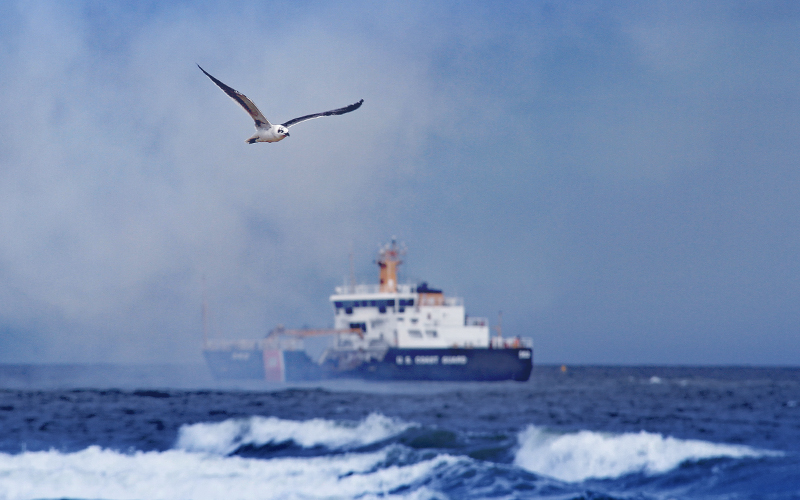The U.S. Coast Guard needs new technology to improve fleet connectivity. That’s the clear message in a recent article published by the Federal News Network. Deputy Chief Information Officer Brian Campo is quoted as saying that the Coast Guard is reaching the limitations of how traditional long-range transmissions can perform.
From the article:
“In the last 18 months, what we’ve done is we’ve doubled cutter connectivity twice, and I would still say that we’re very limited in what we’ve got access to on our cutters,” Campo said on Federal Monthly Insights – Infrastructure Evolution. “When a ship is out on deployment with the Navy, or it’s out doing fishing patrols or out doing immigration operations, we need to be able to get them the data so that they can make informed decisions so that they can engage in the missions that they need to do. And the connectivity options that we have are still pretty limited. So we’re continuing to look for other solutions, we’re continuing to engage with industry to understand what they’re working on.”
The Coast Guard is responsible for enforcing maritime law, search and rescue at sea, transportation security and national defense. The Coast Guard’s mission encompasses different operational programs. In addition to cutters, it operates planes, helicopters and drones. It has the same situational needs as the other uniformed services, often hamstrung by current mobility solutions, as referenced by CIO Campo’s quote.
The Canadian Coast Guard has similar responsibilities; some others are dictated by geography and the elements. Many communities in northern Canada depend on reliable icebreaking by the Coast Guard to keep their communities accessible.
Both organizations require polar coverage, higher throughput, lower latency, and higher resiliency than what can be achieved using geostationary (GEO) satellite connectivity, the current primary means of communications for coast guard vessels. Despite incremental improvements, the Coast Guard needs to leverage performance enhancements being made by private industry. For example, surveillance and rescue missions often require the ability to uplink high-definition video.
Digital technologies are the key to unlocking real-time situational awareness and data analytics, but many new technologies depend on seamless, low-latency connectivity. This is a challenge for many Coast Guard operations, especially deep water and arctic missions which are frequently out of range of terrestrial networks or traditional GEO coverage.
Every maritime vessel must comply with Resolution MSC.428 (98), requiring all ships to include cyber risk management in their systems. Of course, Coast Guard security requirements exceed those of many commercial businesses. As new Low-Earth-Orbit (LEO) networks come online, the security posture of these networks must be carefully examined.
Telesat Lightspeed was designed as the first enterprise-class LEO network with embedded security features. This next-generation constellation focuses on three components that address the needs of the Coast Guard – security, performance, and accessibility.
Telesat’s system architecture and cybersecurity measures go far beyond the requirements of MSC.428 (98). Telesat has adopted the National Institute of Standards and Technology (NIST) Cybersecurity Framework and will meet the U.S. Government standards, including the U.S. Space Force’s Infrastructure Asset Pre-Approval Program (IA-Pre) cybersecurity requirements.
The Coast Guard needs high throughput and data rates, low latency, and constant connectivity at any point on Earth, including in polar regions. Access to government cloud-based applications is being held back due to latency; Telesat Lightspeed provides less than 50 milliseconds round-trip latency, resulting in a faster observe-orient-decide-act (OODA) loop decision cycle.
Telesat Lightspeed satellites each have four optical inter-satellite links (OISLs), which create a mesh network in space, resulting in multiple transport routes of user traffic across the space network. A Coast Guard user can connect directly to the Telesat Lightspeed satellites from anywhere, and data can traverse an optical satellite-to-satellite communications path before downlinking to its final destination – which can be another user terminal or a landing station.
Telesat Lightspeed is designed to deliver unprecedented performance and flexibility. The Phase 1 constellation will offer Multiple Tbps of capacity globally – more than the combined capacity of all geostationary satellites in orbit today. Sophisticated antennas on each Telesat Lightspeed satellite can dynamically focus up to 15 Gbps of capacity to a single location. This capacity can be delivered at a compelling cost per Megabit due to improved network efficiency.
The mission of the Coast Guard is too vital to rely on anything less than the best communications technology available. Enterprise-class LEO is the technology that leaders like CIO Campo have been seeking to ensure total situational awareness, no matter where or when the Coast Guard is needed.



